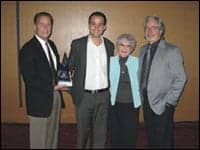June 5, 2008
On March 28, surgeons at UNC Hospitals performed the second implantation in the United States of the Vibrant Soundbridge(r) (VSB) device as a treatment for conductive and mixed hearing loss using direct round window cochlear stimulation.
The Vibrant Soundbridge is reported to be the first U.S. Food and Drug Administration (FDA) approved implantable middle ear hearing device to treat sensorineural hearing loss. Adults with conductive or mixed hearing loss who have been unsuccessful with traditional amplification may be helped by this device.
The surgery was performed by Dr Craig Buchman and Dr. Oliver Adunka, both from the department of otolaryngology-head and neck surgery in the University of North Carolina at Chapel Hill School of Medicine.
"The Vibrant Soundbridge device should provide a solution for a subset of patients that previously had few good options for improving their hearing. Those individuals with hearing loss resulting from hearing bone or ear canal disease now have the opportunity for restoration of normal hearing without the need for a conventional hearing aid," Buchman says.
"The potential benefits are substantial in that the device might eliminate problems with ear canal occlusion, infections, and feedback which are common among certain hearing aid users," Adunka says.
The patient who received the surgery reportedly recovered at home until May 22, when he returned to UNC Hospitals to have the implant activated and its settings adjusted by an audiologist.
The Vibrant Soundbridge is marketed by MED-EL, which has its US headquarters in Durham, NC The device is currently indicated for use in adults who have moderate-to-severe sensorineural hearing loss and who cannot achieve success or adequate benefit from hearing aids or cannot medically tolerate hearing aids. Although the Vibrant Soundbridge is a newly approved device in the US, it has reportedly already been used in thousands of patients in Europe.
The Vibrant Soundbridge is designed to utilize hearing technology that directly drives the ossicular chain (middle ear bones) or other middle ear structures, bypassing the ear canal and tympanic membrane (eardrum). It consists of two major components: 1) the implanted component, called the Vibrating Ossicular Prosthesis(tm) (VORP(tm)), and 2) the externally-worn receiver, called the Audio Processor(tm) (AP), which is approximately the size of a quarter. Unlike a hearing aid, which simply amplifies sound, the Soundbridge is a direct drive prosthetic, which mechanically vibrates structures in the middle ear.
Implantation of the Soundbridge reportedly bears the same surgical risk as any middle ear surgery. The surgical procedure is very similar to that of the approved Vibrant Soundbridge indication and also that of the approved MED-EL Cochlear Implant. It is possible that placement of the device may need to be revised if the optimum outcome is not obtained or if the device migrates from the original position. Trauma to the inner ear during surgery may result in decreased residual hearing.
Trial sites around the country are recruiting subjects in this study. To participate in the clinical trial, subjects must meet inclusion criteria such as having conductive or mixed hearing loss and be at least 18 years of age. Potential candidates may contact MED-EL Toll Free (888) 633-3524, or by e-mail at i[email protected] to learn more about participating in this
trial.
Source: Med-El




